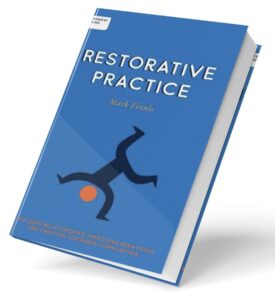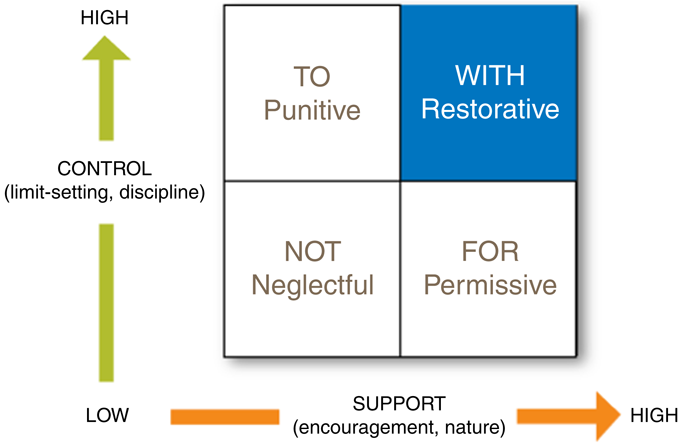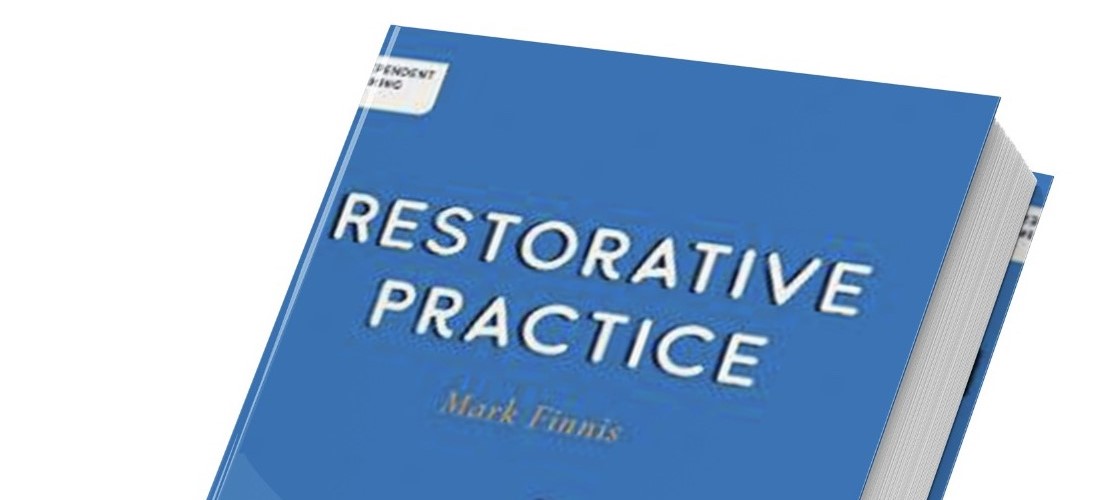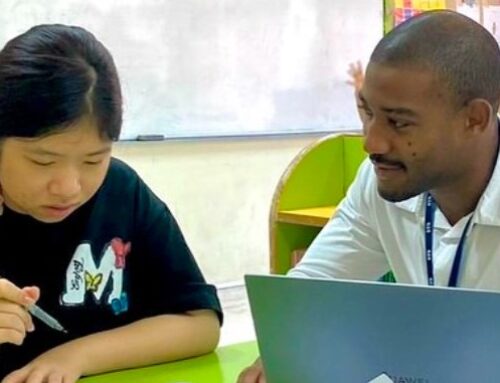By Liam Stewart, teacher in Warsaw, Poland.
After working with restorative practice in the UK, I firmly believe it is an excellent approach to use in education and in life. Restorative practice is intended for teachers working in the UK, but it can be used in any country, as it will help you and your students develop and deal with situations.
Restorative practice is summarised for me by an anecdote shared with me by Mark Finnis, the author of Restorative Practice- a book on education I would hugely recommend.
 Josh (fake name), arrived late to school wearing white trainers and was greeted with a scowl, a finger in his chest and an angry question about why he was late and wearing trainers, Josh responded by telling that teacher to “F*** off” and was sent home. Josh’s swearing was unacceptable but so were the teacher’s actions.
Josh (fake name), arrived late to school wearing white trainers and was greeted with a scowl, a finger in his chest and an angry question about why he was late and wearing trainers, Josh responded by telling that teacher to “F*** off” and was sent home. Josh’s swearing was unacceptable but so were the teacher’s actions.
Through restorative practice, we should try to ‘know our children well’, and if you knew Josh well, you’d know he has trainers on because he can’t afford a proper pair of shoes and is embarrassed by this. Josh is late today because he drops his sister off due his situation at home, meaning he has to.
Restorative practice doesn’t mean ignoring this situation, it just means dealing with it in a better way. Josh should have been greeted at the door that day with a smile and a question about whether he had eaten breakfast- as some students may not have done, with a later conversation about the trainers and lateness. Furthermore, with a positive relationship with Josh this private conversation will go a lot better.
The situation involving Josh may make you feel worried, as your students are strangers to you at first, however, with restorative practice you will build positive relationship. A quote from Mark Finnis I want to share is, ‘relationships aren’t built in a day, they’re built daily’, the right approach daily will build positive relationships and make you an excellent teacher.
Part one: building positive relationships
Connect before content
Can you do me a massive favour? Could you help me move house? If you would said an obvious ‘no’ to these questions, it is because we don’t have a relationship at all. If your closest friend or beloved family member asked, you’d likely (hopefully) say yes to both. I’m not offended by your decision, it’s because you care about them, and a relationship already exists.
Names
Chances are you know the names of the loved ones that you would help move and meet up with. Therefore, the first step in a positive relationship is learning names. Firstly, it will make asking a student to do something a lot easier, and secondly, it shows you care. First of all, ask for students to introduce themselves. If you feel you might struggle with a student’s name ask them in private if you can about how to pronounce their name, this might feel awkward or uncomfortable for you, but it is coming from a place of wanting to get it right. If you mix up student names, forget a name, or mispronounce a name, just offer a quick but sincere apology and move on. Furthermore, if you work in a school, you can ask the other teachers you work with about names to help you learn.
Know your children well and allow them to know you well
Spend time in the day to get to know your students if you can, find out if they have pets, ask them why they want to learn English, or if they want to travel to English speaking countries. Ask your students about the city you are teaching in and where or how you can learn about their culture, ask them what you should do whilst you’re in the country you are in. Making an effort to get to know your students and getting to know their culture will show you care about them. In addition, if you find out something about them you can then ask them about how their pet is, or how their favourite sports team are doing, or what they did at the weekend.
Allow your students to know you well, but know what is appropriate and inappropriate to share, don’t share that you tried the local alcohol for the first time, last night and you’re feeling a bit rough today.
Personal. This would include where you’re from, what you like to do, any pets you have, any TV series’ or films you’ve enjoyed recently. It is important to not immediately share any stories that your students may not be able to access due to their background. Your exciting journeys as a TEFL teacher, or expensive new laptop will be slightly inappropriate if you were talking to a student like Josh who we discussed at the start.
Professional. This is how you share information about you as a teacher, how long you have been doing it. Ensure you are professional at work, put effort in and work hard, your students will be able to tell.
Private. Do not share any private information with students, information that you’d only share with your loved ones is not the type of information you should be sharing.
Seek to understand
When a student is misbehaving it can be frustrating, however, seek to understand why, and keep your frustrations inside- you can vent them later to friends or fellow teachers. All behaviour is due to an unmet need, and often the language we might use does not appreciate this.
Here are some simple changes we could make:
- Attention seeking, change to attention needing
- Challenging behaviour, change to distressed behaviour
- ‘they’re lazy’, change to ‘what is making them struggle to finish?’
- Unacceptable behaviour, change to understandable behaviour
- Make sure you change the language around yourself, if you feel you can’t do something or you are struggling add the word ‘yet’ and you’ll be a lot more hopeful. Here are some examples:
- I can’t teach them, yet
- My lessons aren’t good enough, yet
- I don’t understand the transport in my new city, yet
Positivity, don’t catch them out, catch them in
Ensure you call out good behaviour before you highlight negative behaviour. Earlier, we talked about attention needing behaviour, and in truth everyone needs attention and would not want to be ignored. Therefore, if a student is behaving, highlight their positive behaviour. When highlighting their positive behaviour be specific so they know and the class know why you are pleased with them.
Greetings
Greet students with a smile and, having learned their names, use their names, make every student feel that they belong in your class, you want them there and you are pleased to see them.
Body language
93% of communication is non-verbal (which is good if you’re struggling to learn the language in your new country), so remember, smile, don’t fold your arms, if you need to reprimand a student try not to stand over them, sit beside them or crouch down so you are smaller than them, the chances are you are taller than them so remember this, nobody likes being talked down to.
Part two: dealing with conflict
Conflict happens, dealing with it is key
In every situation there are three truths: my truth, your truth and the truth, and ultimately the truth is it doesn’t matter who is right just that all parties feel listened to and validated. To deal with conflict imagine a story telling timeline with the three bubbles below

When asking what happened, you should aim to empathise and not to blame. Try questions like:
- What do you think has brought us here? (Your answer should not be your flight from your home country)
- What were you thinking at the time?
- What were you feeling at the time?
- When that happened what did you think or feel?
- Anything else?
When asking who has been affected do not stress the impact on yourself first, listen to them impact on them before you do, we will come to discussing how you highlight your dissatisfaction. Try questions like:
- How do you feel now?
- How have you been affected?
- How have you felt since?
- Who else do you think was affected?
- How do you think others might be feeling?
When searching for a solution it is important to not return to the issue that brought you there and seek to blame again. Instead, try questions like:
- What do you think we need to do now?
- What else needs to happen?
- What will help you move on from this?
- How do you feel about what we’ve suggested as a solution?
- What is really important in all this questioning is try to avoid ‘why’ questions, as they often create blame ‘why did you do that?’ ‘why do you disrupt my lesson?’ ‘why are you late’
How to discuss your views:
- Avoid generalisations
Avoid words like:
- ‘never’ in saying ‘you never behave’
- ‘always’, in saying ‘you always disrupt my lesson’
- ‘everyone’, in saying ‘everyone in this class is being disruptive’
- And ‘all’ in saying ‘all of you are being disruptive’
- By saying a student never behaves they will simply (and rightfully) argue about the one time they did behave and cut your argument in half.
- Be specific, ‘when you are disruptive when you talk when I’m talking’
2. Discuss Impact
Use a statement that uses ‘I feel’ not ‘you make me feel’ because the second one creates blame. Make sure you separate the act from the person so you still value them as a person.
3. What I need
Identify what you need going forward for your perfect solution to move forward.
This all sounds like it might take a lot of time, however a simple sentence might be ‘when you disrupt my lesson by talking, I feel a little frustrated because I want to teach you, so what I need is for you to listen when I’m talking just as I want to listen to you if I pick you to speak in lessons.’
Also use this same model for discussing behaviour you like instead of ‘I’m pleased with you’ or ‘I’m proud of you’, try ‘When you worked hard on that piece of work it left me feeling very pleased and I’m really looking forward to that behaviour continuing’. If someone pays you a compliment you’d them to be specific about what they like instead of saying ‘I like you’.
Finally, if you have chance to have these restorative conversations in private. As teachers, we shouldn’t feel surprised that a 14 year old student doesn’t turn around in front of all their friends and say ‘thanks for humiliating me, and telling me off in front of everyone. I’ll amend my inappropriate behaviour’.
Closing thoughts: the perfect place to be: not/to/for/WITH. Challenge and support

When considering where we want to be, let us consider the above box which Mark Finnis first made me aware of with one change, replacing control with challenge.
Low challenge and low support– the NOT box, is the ‘I’m your cover/supply teacher, here are the worksheets, get on with it I won’t help you’, it is the worst place to be and is uncaring, dangerous and neglectful towards children.
High support and low challenge– the FOR box, is where a teacher does things for students, turning a page because a student is on the wrong page. It is easy to do things for students, however, if they grow used to it they will have no independence. Furthermore, if you do things for anyone that they should be doing themselves they will grow used to this, and you’ll be blamed if it goes wrong.
High challenge low support– the TO box, is where the teacher rules by fear. This may seem to some that this situation is okay, the teacher talks and the students listen, however, respect and fear are different things. Furthermore, the teacher being present is key to this method, when the teacher is not there what will the students do?
High challenge and high support– the WITH box, students know what to do due to the challenge of the situation, and know how to do it due to the support they have, this does not simply apply to work but also applies to life.
Finally, this article needs several references for my inspirations around using restorative practice. Thank you to Carr Manor Community School in Leeds, where they have used restorative practice for years and I first worked with it.
Thank you to, Parkside School in Cullingworth, where I first met Mark Finnis on a training day as they made the excellent decision to start using restorative practice.
Obviously, thank you to Mark Finnis for your work on restorative practice. Research of any of the these three entities will provide greater detail on restorative practice and I wish you success in using restorative practice.
Ready to take the ESL classroom by storm? Explore our programs in Vietnam, Thailand, China, Cambodia or Poland or send in an application.
Or, if you’re still not sure, drop us a message; we’re here to help.




